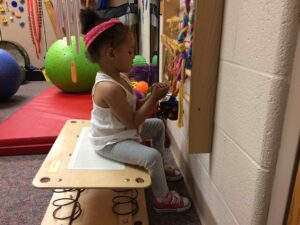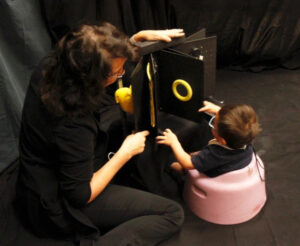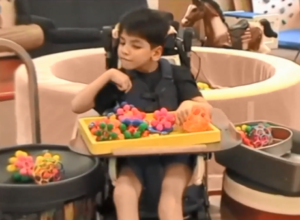Implementation

Active Learning is more than equipment or materials. It is an approach that can be used to implement instruction in general curriculum and expanded core curriculum, and also to support therapies such as physical therapy, occupational therapy, music therapy, and speech therapy. These ideas can also be used in the home or community.
Some things to keep in mind when using an Active Learning approach in any type of instruction, therapy, or play activity:
- Use the appropriate educational technique (see the Five Phases of Educational Treatment).
- Match your pace to the learner when you interact.
- Follow the learner’s lead in any activity.
- Don’t over-react or over praise the learner – if the child becomes upset, simply move on or if the child demonstrates a skill simply comment on what he/she has done
- Be aware of the type of skills the learner is working on in the activity or environment, e.g., in the Little Room the focus is on tactile/motor/auditory not visual skills.
- Select materials that are based on the child’s sensory preferences and developmental level.
- Arrange materials so the learner has physical access to explore independently.
- Position the learner so he/she can move optimally.
- Remain silent during the child’s exploration – share simple feedback when the learner takes a break or at the end of the activity.
- Allow plenty of time for the learner to respond – for some learners this may be minutes rather than seconds.
- Recognize that the child needs to work at their current skill level and will attempt higher level skills when the learning cycle has been completed (see Dynamic Learning Circle).
- Observe the child and your own interactions – videotape the child and/or the adult during instruction periodically.
- Use a wide variety of materials with differing properties.
- Change only one feature at a time in the materials or environment.
Setting Up the Day
Every child deserves a rich program of instruction. This means that good use is made of every moment of the school day. Though some children have less stamina due to physical and medical challenges, their stamina often improves if they are actively engaged throughout the day.
Start with the schedule established for your classroom in general.
Which activities can the child actively participate in with or without some modifications or supports? Consider how to make these times meaningful and motivational for your student. For example the child may enjoy interacting with a larger group and need minimal support during group music time. On the other hand, morning circle that is not adapted to meet the child’s cognitive, social, emotional or physical level even with modifications and support may serve no purpose for the child. In that instance the child would probably benefit from spending part or all of that time doing some other Active Learning Activity.
Determine when related services need to be provided and when.

Children with significant developmental delays, generally have many related services provided in their program. If any of these services require direct therapies for the child, determine when these need to occur. Then figure out how these therapies can be reinforced throughout the day or week using either adult-child interactions or independent play in Active Learning environments. For example, the OT is working on helping a child to open a fisted hand during therapy on Monday and Wednesday morning for 30 minutes. Set up the schedule so she plays independently with a Scratch Board or Elastic Board on Tuesday and Thursday. On Friday perhaps, she interacts with an adult to strum various stringed instruments or objects on Friday.
Use independent play and activities of daily living to fill in the time.
After determining times for group activities, related services and therapies, schedule in activities of daily living such as toileting, eating, and hygiene. With what ever time you have left in the day schedule independent or adult-child interaction play. Dr. Nielsen suggests alternating between fine and gross motor activities and including at least 45 per day of adult child interaction time.
Note: Some children appear to need to sleep most of the day. While this might be necessary occasionally, generally this is a sign that the child is either bored or averse to the materials and activities being offered. If you notice a child needing to sleep a lot, make sure to understand the cause(s). Is the child sick? Is there a problem with medications? Are goals and objectives targeting the child’s developmental level? Are the activities and materials preferred and motivating to the child?
Make sure that the student has time for both independent play and interactive play.

Some children are very passive and will only become active if an adult engages with them. These children need to become motivated to explore and move on their own. Other children never want to engage with adults except as a “tool” to get something they want. They only want to engage with objects while being left alone. The goal is to help the child find enjoyment in both types of activities. Try to establish a balance between independent activities and those that involve either peers or adults.
Instead of giving a child “down time” give the child time in a Little Room, with a Position Board, or on a Resonance Board. If the child has to spend time in restrictive positioning equipment such as a standing frame or side-lying frame, utilize things like Mobiles, Wrist Scarves, or Vests to provide something for him to do during that time.
Make the schedule as flexible as possible.
There will be days when the child doesn’t want to do the activities you have planned in the order or for the length of time you have planned. Be as flexible as possible with the schedule. If the child is actively engaged in learning and you can continue the activity, then do that. If the child has stopped being engaged or just doesn’t want to do the planned activity, offer another option.
Recognize that some days will be better for the child than others and don’t beat yourself up if you can’t fit everything in during the school-day. A child who is sick or distressed may not be able to engage. Offer activities that comfort and sooth if need be. After a little time try another scheduled activity.
You may want to use this Active Learning Materials and Activities Planning Sheet form to help your team get started planning for your student.
Active Learning Materials and Activities Planning Sheet (Word Version)
Active Learning Materials and Activities Planning Sheet (PDF Version)
Rylan Before & After
Description: Two clips illustrate how important adult expectations are and what a difference the environment makes in encouraging learning and active engagement.
In the first clip a young boy lies on a swing in a supine position. His lower body is covered with a blanket. In the second clip, just a few minutes later, the blanket has been removed and Active Learning materials have been placed all around the boy. A bead clamp is suspended above his legs, an elastic board under his right arm, and a door stop board under his left arm. There is silver metallic crinkle paper under his head.

